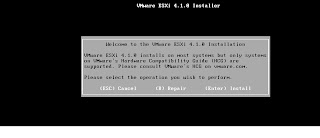Install Vmware Esxi
Architecture :x86_64
Memory : 2 GB
Virtualization Software : Vmware Esxi 4.1
Download vmware Esxi from http://www.vmware.com.
Start the Installation:
Now you are ready to boot the server off your ESXi CD, which should load this screen:
Press Enter to start Esxi installation,then you will see following screens.
Now again press Enter to start installation and then press F11 to accept and continue.
The next screen will prompt you to choose which drive you wish to install ESXi on, in this example I have only one drive with 1GB available space and press Enter to continue.
 |
Press F11 to start installation.
When it is complete it will prompt you to remove the CD and reboot the system. Provided your boot order is correct (and if it isn't you will need to check in the BIOS) the server should now boot into ESXi for the first time:
If you don't have DHCP server running then customize the system by assigning static IP address to the esxi server.
Press F2 and it will ask for root password.First time setup Press Enter with out typing password and you will see below screen.
username : root
password : pass(you can change it according to your environment).
The first thing you should do is set the root password so leave "Configure Password" selected and press Enter to change it, then enter a suitably complex password. Next you need to configure the management network, so select that option and enter a static IP address and your other network details.
You can change IP configuration by entering into the following screen.
Now open the web browser and enter give ip addrees to access Esxi host.
Now you can download vSphere clinet from the above link (Download vSphere Client).
Please see below screen shot of vSphere client from my environment.















No comments:
Post a Comment